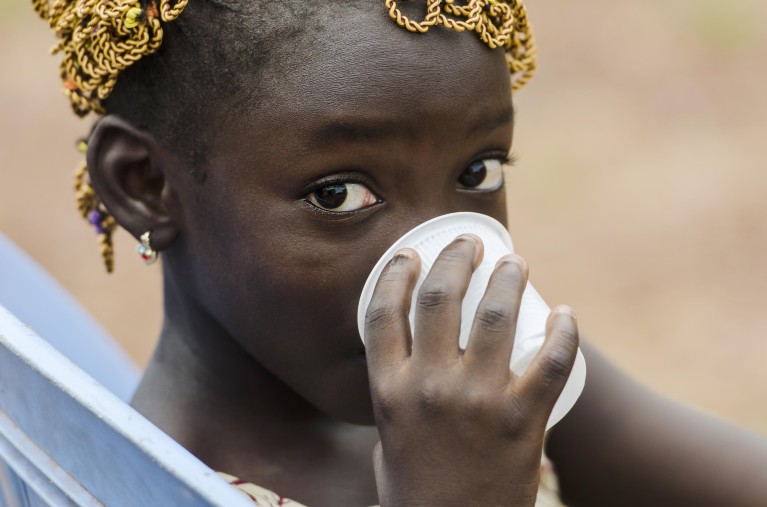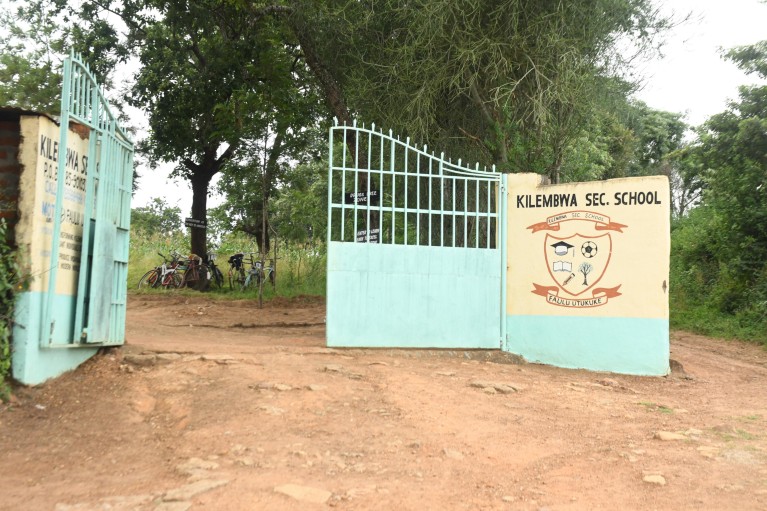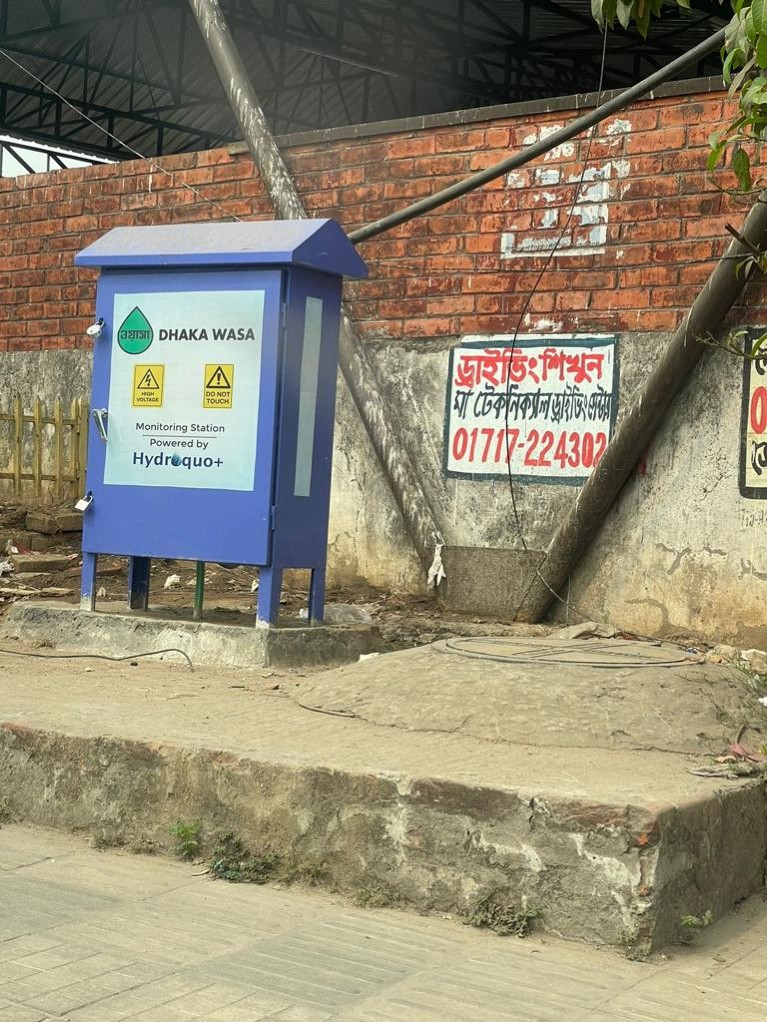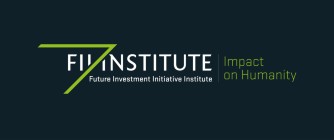
Water scarcity affects many parts of the world. In Africa, water collection often falls to women and girls, taking them out of school and perpetuating poverty.Credit: Riccardo Mayer/ Shutterstock
The people in Andhra Pradesh in southern India, Machakos county in Kenya, and Dhaka, the capital of Bangladesh, may be thousands of miles apart, speaking diverse languages, but they share the common challenge of securing clean and safe water supplies.
Globally, demand for water has outpaced population growth, and global warming is projected to worsen the water crisis. In 2022, 2.2 billion people could not access safe drinking water, while 3.5 billion people lacked sanitation.
Millions of people die each year from problems related to water, sanitation or hygiene. Drinking unsafe water risks infections such as diarrhoea, typhoid, cholera, and has also been linked to stunted development and malnutrition in children. Water scarcity has a further adverse impact on young girls and women in particular, who are most likely to have to fetch water, which in some parts of Africa can take up to six hours every day.
Improving access to safe water, therefore, has society-wide effects: from basic health, livelihoods and wellness, to agriculture, education and the environment. Each of these highlighted organizations, Kenya Connect, India’s Grameena Vikas Kendram (GVK), and Bangladesh’s Hydroquo+, tackles different aspects of the water resource challenges, be it related to infrastructure, purification methods, or ensuring water quality and supply. Such initiatives might be on a small scale, but they all contribute to efforts to reach the sixth UN Sustainable Development Goal, which is universal access to water and sanitation by 2030.
Education the whole year around
The non-governmental organization Kenya Connect is addressing lack of access to clean water in rural Kenya by engaging with and supporting local communities to manage resources sustainably.
“In the area where we work, the sources of water are seasonal streams which dry up after the rains,” says Patrick Munguti, director of education and information technology at Kenya Connect. The rainy seasons in the Mwala region of Machakos county run from November to December and from March to May. For those who can afford it, water can be collected and stored in water tanks for use.
However, many households and community organizations cannot afford their own water tanks. People have to rely on river water or the nearest earth dam or borehole. “Students had to carry water to school for drinking, and often the water was collected from unsafe sources,” adds Munguti. “The task of carrying water to school is cumbersome, especially for the young kids.”
Kenya Connect initiated this programme by asking the parents and teachers of the area’s children about their most urgent needs. “One of the needs was water,” says Munguti, “both lack of access to water, and lack of clean water — which resulted in water-borne diseases.”
In partnership with FII Institute, Kenya Connect supplied and installed 10,000-litre water tanks and water-harvesting gutters for 63 Mwala public schools, each with 200-300 children. Munguti explains that school administrators were also trained on the importance of sanitizing the full water tanks with chlorine, as well as the correct chlorination process. Each tank provides drinking water for all students for up to two months, as well as water for cooking meals for schools that provide food.
In order to extend the supply of safe water to four or five months, Kenya Connect is aiming to install a second water tank for each school. So far, they have completed installation for 26 schools. “We are working to ensure all the other schools get an additional tank,” says Munguti.
The organization hopes to extend its work to more rural areas. It also plans to drill a borehole for a school with special-needs students with multiple disabilities, who may require extra water for cleaning. “Ensuring adequate water supply means students do not have to miss school altogether due to lack of it,” says Munguti.

One of the 26 schools that received a 10,000 litre water tank from Kenya ConnectCredit: TKTK
Sustainable farming livelihoods
Agriculture is the largest user of freshwater. For subsistence farmers, such as those in in the Eastern Ghats hills of Andhra Pradesh, lack of water is an issue not just for their crops but also for themselves.
GVK, based near Visakhapatnam, is working with indigenous communities, says Ambavaram Aneel, chief functionary of GVK. The organization has been engaging with farmers, many of whom are women, to improve their livelihoods since 2017. Its initial focus was to replace the water-intensive and expensive genetically modified cotton, dominant in Andhra Pradesh state, with organic cotton seeds that can be grown without the use of chemical fertilizers and pesticides, and does not require as much irrigation. “As part of this effort, we are promoting sustainable agriculture, organic agriculture, biodiversity and water conservation,” says Aneel.
GVK is developing an innovative, regenerative and circular model to help improve the livelihoods of these farmers. Regenerative agriculture can improve water management at various levels: it helps soils absorb and retain more water, reducing reliance on rainfall or irrigation. Higher retention of soil water helps reduce rainwater run-off and soil erosion, and improves seepage into groundwater, soil fertility and biomass accumulation.
Since 2023, GVK has expanded its attention to include drinking water. It is working with more than 21,000 small-scale, marginal and tribal farmers in Andhra Pradesh and the neighbouring state of Telangana. Through community meetings with villagers, GVK addresses challenges in water supply and maintenance. “We foster transformative change by partnering with local communities and actively involving them in sustainable development, with a specific emphasis on effective water management," Aneel says.
In the 20 tribal villages grappling with drinking water challenges, there are no grassroots organizations. Instead, Village Water and Sanitation Committees (VWSCs) established by Indian states, manage water resource programmes, “but unfortunately, they are inactive due to a lack of community support,” says Aneel. “Reactivation and restructuring of these committees are essential.” When operational, the VWSCs play a crucial role in overseeing water management, watershed development, and drinking water projects in villages, he adds.
It is early days, but Aneel hopes to support vulnerable families by providing access to safe drinking water, thereby reducing exposure to water-borne diseases.

Monitoring water in real time provides valuable data to make better use of this valuable resourceCredit: TKTK
Water data to the fore
At the other end of the scale from grassroots initiatives are high-tech interventions, such as the use of artificial intelligence (AI) and machine learning. These technologies can help solve water issues by gathering and analysing data to better manage resources.
In Bangladesh, 68 million people, or about 40% of its population, lack access to a reliable, safely managed water source; 100 million people lack access to safely managed toilet facilities.
Dhaka-based Hydroquo+ is a start-up that helps national agencies as well as public and private organizations solve water-related issues using data analysis. “Water security today entails managing not only the water you always assumed was accessible, but also water amid even greater extremes of excess and shortage than we have seen in the past,” says Zahin Razeen, its founder and chief executive officer.
Hydroquo+ uses sensors, software and analytics to improve transparency for water utility operators dealing with the availability and quality of treated water, through the distribution network to the end-user, Razeen explains. Water testing is done in real-time (every two minutes) and encompasses more than 18 parameters including turbidity, total suspended solids and total carbon. It has been collecting these data for the past three-and-half years.
One of its major clients is the Bangladesh Water Supply and Sewage Authority (WASA) that is responsible for managing the waste of, and providing water to, more than 20 million residents of Dhaka. WASA initially had a maximum sampling capacity of 500 tests per month. In a pilot concept supported by the Asian Development Bank and Japanese International Cooperation Agency (JICA), Hydroquo+ replaced these manual, slow and expensive lab tests with its automated system that can not only analyse the safety and composition of water but also detect leaks, improve water use efficiency, and correlate the data with planning models and consumer behaviour to forecast future requirements.
It’s not just urban water supply. In agriculture, Hydroquo+ can estimate the water demand of specific crop systems and schedule irrigation accordingly: advising when, where and how much to irrigate and, thereby, maximize water-use efficiency and crop yield.
The company has also developed and deployed an automated sensor-based station for textile manufacturers to monitor effluent discharge in real-time and generate an alarm when maximum permissible thresholds are breached. Artificial intelligence and machine learning helps optimize the wastewater treatment process, reduce costs, and improve the safety and efficiency of wastewater treatment plants, says Razeen.
Water is a focal issue
Water management is most likely to succeed with it enjoys both community and governmental support. Kenya, for example, has several laws including the Kenya National Water Policy 2021 and the Water Act 2016, but lacks impact at the implementation level. Kenya Connect’s work therefore helps fill these gaps, and the organization is careful to avoid duplicating local governments’ efforts.
Meanwhile, in India’s decentralized local governance system, village councils called ‘gram panchayats’ help design, implement and maintain water supply services, with active community participation. The councils are also responsible for water conservation initiatives — ensuring community ownership of water management, says Aneel.
One key advantage of these local efforts is that they are easy to replicate, as they do not cost much, Munguti points out. Another advantage is that they include many different people. “Youth participation infuses these efforts with vibrant energy and enthusiasm,” says Aneel. “Encouraging students to learn about and teach water management fosters a sense of responsibility and innovation within communities, contributing to long-term sustainability.”
Razeen agrees, seeing that young people and startup companies offer the greatest potential to shift the paradigm and lead to breakthroughs. “Over the next few years,” he predicts, “water will become the focal point, and the youth will be instrumental in navigating the new compass for sustainable water equity for all.”


